How to make cream choux and Japanese roll cake with Andrew Gravett
Pastry chef Andrew Gravett shows us how to make the ultimate afternoon tea cakes with a Japanese twist...


Fancy making afternoon tea cakes with a twist? Andrew Gravett, London's Executive Pastry Chef at The Langham shares his best Japanese-style afternoon tea cake recipes: Cream choux buns and Japanese roll cake.
The Langham London is famous for being the birthplace of afternoon tea, many of its cakes created by Andrew Gravett. Often afternoon tea cakes are perceived as hard to make but chef Andrew shares his expert tips and demonstrates just how simple and straightforward they can be to make in our step-by-step video guide.
Preparation: To make these dainty afternoon tea cakes, you will need some professional baking equipment including a silicone baking mat, as this will make sure your cakes do not stick to the bottom of your tray, and piping bag. If you can't get hold of a piping bag or would prefer to not buy one, you can use a spoon for your choux buns and a baking spatula for your Japanese roll cake. However, using these may not achieve the same design as Andrew's.
For your cream choux buns, it is optional on whether you want to make some sweet pastry discs to go on top of your buns before making them. Andrews uses them to simply keep the choux buns in place as well as give them a crunchy texture. He recommends making them the night before making your afternoon tea and storing them in the fridge.
Another thing you can do ahead of your afternoon tea is to make the vanilla mousseline cream the day before. Simply just store in the fridge overnight and serve when needed.
You can also make your cherry jam to go inside the cream choux buns before making them. Andrew uses cherries, a little bit of sugar, and some pectin to set the jam. If you don't have time to make the jam, a shop-bought cherry jam will work just as well.
Finally, you could also cut up any decoration you will need for both your cakes ahead of time. Just slice up your strawberries and cherries into halves and store them in the fridge in an airtight container until they are needed.
GoodtoKnow Newsletter
Parenting advice, hot topics, best buys and family finance tips delivered straight to your inbox.
Watch how to make the ultimate cream cakes for your afternoon tea with Andrew Gravett
Ingredients:
For the vanilla mousseline:
- 500g milk
- 25g plain flour
- 90g caster sugar
- 90g egg yolks
- 130g butter
- 50g mascarpone
For the choux buns:
- 125g milk
- 125g water
- 7g caster sugar
- 7g salt
- 112g butter
- 140g plain flour
- 250g whole eggs
- Cherry jam, to fill the buns with
- Cherries, to decorate
For the Japanese roll cake:
- 280g milk
- 45g butter
- 1g salt
- 90g egg yolks
- 35g caster sugar
- 45g plain flour
- 135g egg whites
- 50g sugar
- Strawberries and marmalade, to fill
How to make the vanilla mousseline cream
Step 1
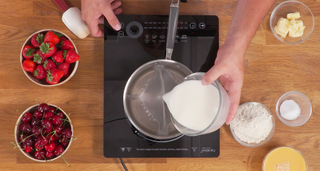
Bring to boil the milk with a vanilla pod. Let it infuse for 10 min and sieve.
Step 2

Meanwhile mix with a whisk in a bowl flour, caster sugar and egg yolk.
Step 3

When the liquid boils, temper the egg mix and add it to the pan with the rest of the milk. Boil for 1 minutes.
Step 4

Let it cool down to 40C and add the butter cut in small pieces. Blend to smooth texture and keep it refrigerated.
Before using it, add the mascarpone and mix with a whisk to a smooth texture.
How to make choux buns
Step 1
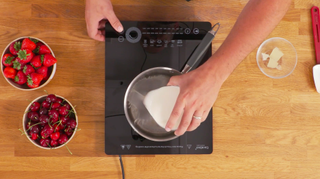
Preheat the oven to 175C.
Boil together the water, milk, salt, sugar and butter.
Step 2
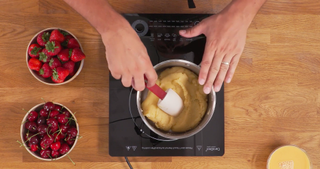
Make sure the butter is completely melted before adding the flour. Once the flour is been added, mix well over the heat for 2 minutes.
Step 3
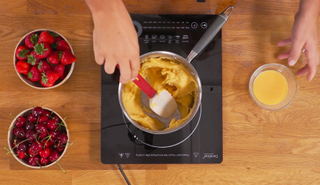
Let it cool down before start adding the eggs.
Add the eggs one by one until the dough is homogeneous.
Step 4
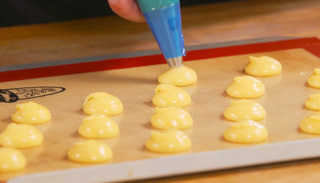
Pipe onto a tray and bake for 175C for 30 min. Once the choux is cooked turn off the oven and keep the door ajar to let them dry.
Step 5

Fill with cherry jam and the vanilla mousseline.
Step 6
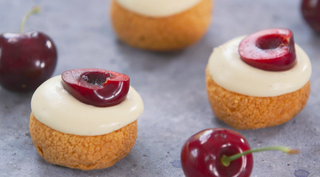
Top with a cherry.
Watch how to make a Japanese roll cake with Andrew Gravett
How to make a Japanese roll cake
Step 1

Preheat the oven at 160C.
Mix egg yolk, sugar and flour in a bowl with a whisk.
Step 2
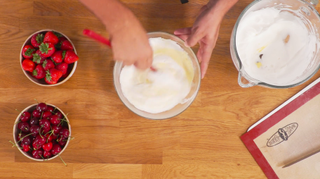
Meanwhile whip the egg whites with the sugar to form a meringue. Mix into the egg yolk mixture to get a soft sponge batter.
Step 3
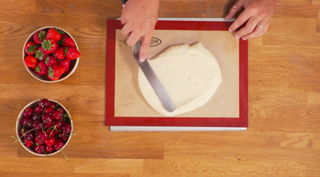
Once you've folded the cream into the meringue and spread onto a baking tray.
Step 4

Bake at 160C for 35 min.
Trim to desired size.
Step 5

Cover the sponge with a thin layer of vanilla mousseline.
Step 6
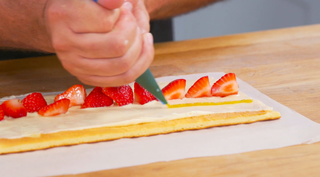
Pipe on thin lines of marmalade, and fill with quartered strawberries.
Step 7
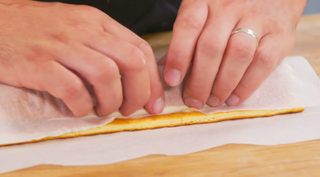
Roll from the long side, over once.
Step 8
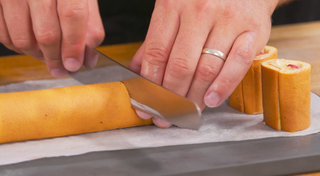
Slice to desired size.
Step 9

Serve and enjoy!
Top tips for making cream choux and Japanese roll cake
For the cream choux buns, Andrew says; "when making the choux pastry, it essential to make sure you dry the pastry out by taking it off the heat and using the existing heat in the pan and folding it so that you get out all the excess moisture. Also when adding the eggs to the pastry, you should gradually add your eggs to your mixture, so that you get it nice and smooth."
For the vanilla mousseline cream, which is used for both of these afternoon tea cakes, it is really important that you dissolve the sugar in the eggs first. If you don't do this first, the sugar will absorb the moisture of the eggs and you will be left with a lumpy cream. Also, when creating the base of the cream using milk, Andrew uses gelatin powder. To make it perfect for this cream, he says that you should use 1g of powder and 5g of water and this should be added to the cream once it is cooked and should let it dissolve while it is still warm.
Andrew adds; "It is really important that you make sure you let your cream reach 40C before adding in your melted butter. Then voilà, your cream will be ready to go."
Moving on to the Japanese roll cake, it is essential that you follow all of Andrew's tips and tricks. "For the meringue sponge, it is really important to not add the sugar in too early, otherwise there will be less air in the meringue. Also, it is important to only whisk your meringue on a medium speed, as you want it to have an elastic texture and have a light foam to it," says Andrew.
It is also vital when you finally mix it with the base of the sponge, which is the hot cream, that you mix some of your meringue mixtures into your cream mixture first. Andrew advises this because it will help to make the two textures similar when mixing them finally together to make the sponge.
Another tip from Andrew to finish off your amazing Japanese roll cake is to add two small strips of marmalade into your cake to add a bit of acidity and bitterness to your cake so that it is not too overwhelmingly sweet. This is something they exclusively use in their roll cakes at The Langham hotel, so definitely is worth a try. Also make sure you save some mousseline cream to decorate your cake. If not, whipping cream will work just as well.
What makes vanilla mousseline cream different?
Vanilla mousseline cream is the traditional pastry cream used in many favourite pastries. Using lots of softened silky butter, it is an ultra-indulgent cream and when piped has a super professional and beautiful look to it.
Traditionally, many chefs add vanilla to the cream to give it a sweet finish that compliments most pastries perfectly.
How to store vanilla mousseline cream?
According to cookist, you can store mousseline cream for up to 1 day in the fridge after making it. Just make sure you wrap your bowl of cream tightly in cling film and get it out of the fridge at least half an hour before using it, so you can get it to room temperature. Once it is at the right temperature, whisk it up again to soften it and use it as you please.
How to store afternoon tea cakes
Both these cakes generally can be stored in an airtight container in your cupboard or larder for up to 1-2 days. Any longer and they may become dry.
If you wanted to keep them for a few more days, you could put them into your fridge but it is important to know that pastries and cakes tend to become drier in the fridge, as the cooler temperatures tend to draw the moisture out of them.
Why was afternoon tea invented?
Afternoon tea is quintessentially British. It all started back in the 17th century when the 7th Duchess of Bedford complained that she always had a sinking feeling in the afternoon and her solution was a pot of tea and a light snack that was privately taken in the afternoon.
She then started inviting her friends to join her for her afternoon tea and soon many people picked up on the idea and the practice became respectable enough to move into the drawing room.
Traditionally it started off as only an upper classes tradition, but soon most of society was sipping on tea and nibbling on sandwiches late afternoon. Fast forward to now, despite afternoon tea still being a thing in Britain, it is very much an occasional luxury for many of us and is normally full of elegant sandwiches, savoury goods, and sweet cakes and tarts.
Our best afternoon tea cakes
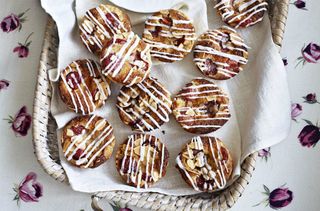
1. Cherry Bakewells
These Bakewell tarts are a twist on your traditional Bakewells, instead of using fresh cherries. With ready-made short-crust pastry, these tarts are super tart and delicious and are the perfect addition to your afternoon tea.
Get the recipe: Cherry Bakewells
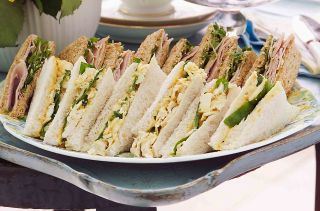
2. Coronation-style chicken sandwiches
Little sandwiches are a necessity in an afternoon tea selection and what better sandwich to make than the British classic coronation?
If you fancy a few other sandwich fillings, check out our sandwich fillings and recipes.
Get the recipe: Coronation-style chicken sandwiches

3. Sultana scones
Classic scones as we all know are always part of a British afternoon tea. Light and fluffy filled with a rich amount of sultanas, these scones are truly scrumptious.
Get the recipe: Scones
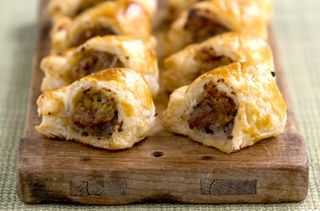
4. Honey and mustard sausage rolls
A recipe that is a great way to spice up your usual sausage rolls and the perfect savoury addition to your afternoon tea.
Get the recipe: Honey and mustard sausage rolls

5. Scotch eggs
These are no ordinary scotch eggs, these are Tim Anderson's Japanese-style scotch eggs, filled with pork and punchy flavours of spring onion, garlic, and soy. A perfect treat to add to your afternoon tea.
Get the recipe: Scotch eggs

Andrew Gravett is a English-French chef who specialises in all things baking and pastries. Currently executive chef at The Langham hotel in London, his career has been inspired by his love for baking and his French mother's way of cooking. Andrew took himself off to Normandy in France where he was trained in pastry shops and soon developed a passion for the craft. Coming back to England, Andrew has worked in Michelin-starred restaurants and worked with household chocolate producer Valrhona. After taking some time out, Andrew felt the call of the kitchen once more and now has made his dream menu at The Langham and is in charge of one of the most famous afternoon teas in London.
Related features:
How to make jam with Andrew Gravett
How to make scotch eggs with Tim Anderson
How to make katsu sando with Tim Anderson

Christina Geggus is Junior Food Writer at Goodto.com and enjoys writing about lifestyle, food, and recipes. After completing her Master’s in Magazine Journalism at Nottingham Trent University and her undergraduate degree in Communication & Society and Global Studies alongside receiving an NCTJ diploma, Christina has always set her sights on a career in journalism.
- Rosie ConroyFood Writer